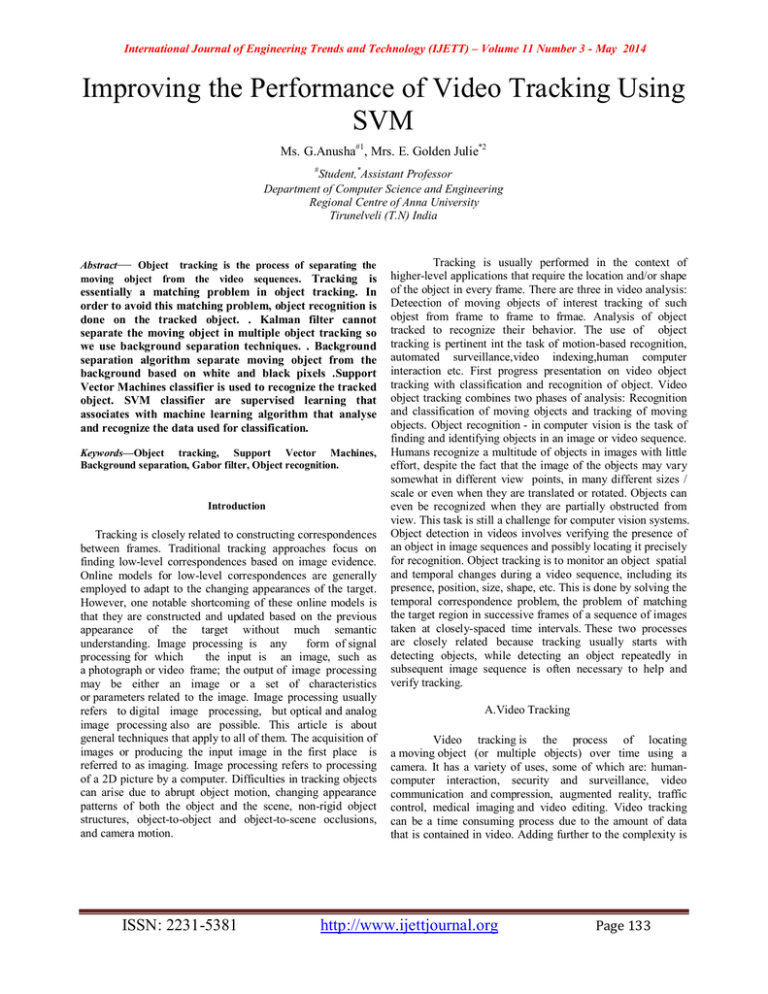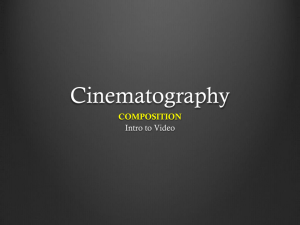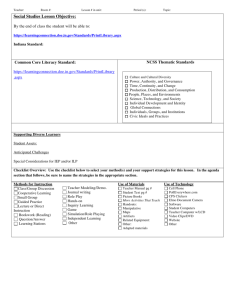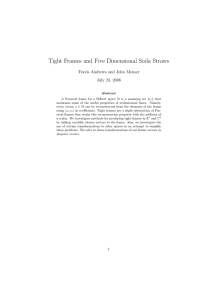Improving the Performance of Video Tracking Using SVM
advertisement

International Journal of Engineering Trends and Technology (IJETT) – Volume 11 Number 3 - May 2014
Improving the Performance of Video Tracking Using
SVM
Ms. G.Anusha#1, Mrs. E. Golden Julie*2
#
Student,*Assistant Professor
Department of Computer Science and Engineering
Regional Centre of Anna University
Tirunelveli (T.N) India
Abstract— Object tracking is the process of separating the
moving object from the video sequences. Tracking is
essentially a matching problem in object tracking. In
order to avoid this matching problem, object recognition is
done on the tracked object. . Kalman filter cannot
separate the moving object in multiple object tracking so
we use background separation techniques. . Background
separation algorithm separate moving object from the
background based on white and black pixels .Support
Vector Machines classifier is used to recognize the tracked
object. SVM classifier are supervised learning that
associates with machine learning algorithm that analyse
and recognize the data used for classification.
Keywords—Object tracking, Support Vector Machines,
Background separation, Gabor filter, Object recognition.
Introduction
Tracking is closely related to constructing correspondences
between frames. Traditional tracking approaches focus on
finding low-level correspondences based on image evidence.
Online models for low-level correspondences are generally
employed to adapt to the changing appearances of the target.
However, one notable shortcoming of these online models is
that they are constructed and updated based on the previous
appearance of the target without much semantic
understanding. Image processing is any
form of signal
processing for which
the input is an image, such as
a photograph or video frame; the output of image processing
may be either an image or a set of characteristics
or parameters related to the image. Image processing usually
refers to digital image processing, but optical and analog
image processing also are possible. This article is about
general techniques that apply to all of them. The acquisition of
images or producing the input image in the first place is
referred to as imaging. Image processing refers to processing
of a 2D picture by a computer. Difficulties in tracking objects
can arise due to abrupt object motion, changing appearance
patterns of both the object and the scene, non-rigid object
structures, object-to-object and object-to-scene occlusions,
and camera motion.
ISSN: 2231-5381
Tracking is usually performed in the context of
higher-level applications that require the location and/or shape
of the object in every frame. There are three in video analysis:
Deteection of moving objects of interest tracking of such
objest from frame to frame to frmae. Analysis of object
tracked to recognize their behavior. The use of object
tracking is pertinent int the task of motion-based recognition,
automated surveillance,video indexing,human computer
interaction etc. First progress presentation on video object
tracking with classification and recognition of object. Video
object tracking combines two phases of analysis: Recognition
and classification of moving objects and tracking of moving
objects. Object recognition - in computer vision is the task of
finding and identifying objects in an image or video sequence.
Humans recognize a multitude of objects in images with little
effort, despite the fact that the image of the objects may vary
somewhat in different view points, in many different sizes /
scale or even when they are translated or rotated. Objects can
even be recognized when they are partially obstructed from
view. This task is still a challenge for computer vision systems.
Object detection in videos involves verifying the presence of
an object in image sequences and possibly locating it precisely
for recognition. Object tracking is to monitor an object spatial
and temporal changes during a video sequence, including its
presence, position, size, shape, etc. This is done by solving the
temporal correspondence problem, the problem of matching
the target region in successive frames of a sequence of images
taken at closely-spaced time intervals. These two processes
are closely related because tracking usually starts with
detecting objects, while detecting an object repeatedly in
subsequent image sequence is often necessary to help and
verify tracking.
A.Video Tracking
Video tracking is the process of locating
a moving object (or multiple objects) over time using a
camera. It has a variety of uses, some of which are: humancomputer interaction, security and surveillance, video
communication and compression, augmented reality, traffic
control, medical imaging and video editing. Video tracking
can be a time consuming process due to the amount of data
that is contained in video. Adding further to the complexity is
http://www.ijettjournal.org
Page 133
International Journal of Engineering Trends and Technology (IJETT) – Volume 11 Number 3 - May 2014
the possible need to use object recognition techniques for
tracking. The objective of video tracking is to associate target
objects in consecutive video frames. The association can be
especially difficult when the objects are moving fast relative
to the frame rate. Another situation that increases the
complexity of the problem is when the tracked object changes
orientation over time. For these situations video tracking
systems usually employ a motion model which describes how
the image of the target might change for different possible
motions of the object. Examples of simple motion models are:
When tracking planar objects, the motion model is a 2D
transformation (affine transformation or homography) of an
image of the object (e.g. the initial frame).When the target is a
rigid 3D object, the motion model defines its aspect depending
on its 3D position and orientation. For video compression, key
frames are divided into macroblocks. The motion model is a
disruption of a key frame, where each macroblock is
translated by a motion vector given by the motion parameters.
Filtering and data association is mostly a top-down process,
which involves incorporating prior information about the
scene or object, dealing with object dynamics, and evaluation
of different hypotheses. These methods allow the tracking of
complex objects along with more complex object interaction
like tracking objects moving behind obstructions. Additionally
the complexity is increased if the video tracker (also named
TV tracker or target tracker) is not mounted on rigid
foundation (on-shore) but on a moving ship (off-shore), where
typically an inertial measurement system is used to prestabilize the video tracker to reduce the required dynamics and
bandwidth of the camera system.
I.
RELATED WORK
A. Object Tracking : A Survey
Object tracking is an important task within the field of
computer vision. There are three keys steps in video analysis:
detection of interesting moving objects, tracking of such
objects from frame to frame and analysis of objects tracks to
recognize their behaviour.
Object representation:
Points. The object is represented by a point, that is, the
centroid or by a set of points. In general, the point
representation is suitable for tracking objects that occupy
small regions in an image.
Primitive geometric shapes. Object shape is represented by a
rectangle, ellipse etc. Object motion for such representations
is usually modeled by translation, affine, or projective. This
representing is suitable for tracking non rigid object.
Object contour. Contour representation defines the boundary
of an object.
ISSN: 2231-5381
Articulated shape models. Articulated objects are composed of
body parts that are held together with joints. For example, the
human body is an articulated object with legs, hands, head,
and feet connected by joints.
Skeletal models. Object skeleton can be extracted by applying
medial axis transform to the object contour. This model is
commonly used as a shape representation for recognizing
objects.
Color. The apparent color of an object is influenced primarily
by two physical factors,1) the spectral power distribution of
the illuminant and 2) the surface reflectance properties of the
object. In image processing, the RGB (red, green, blue) color
space is usually used to represent color.
Edges. Object boundaries usually generate strong changes in
image intensities. Edge detection is used to identify these
changes.
Optical Flow. Optical flow is a dense field of displacement
vectors which defines the translation of each pixel in a region.
Texture. Texture is a measure of the intensity variation of a
surface which quantifies properties such as smoothness and
regularity.
Video tracking and recognition uses the Appearance-Adaptive
Models. It incorporates appearance-based models in a particle
filter to realize robust visual tracking and recognition
algorithms. In conventional tracking algorithms, the
appearance model is either fixed or rapidly changing.The
motion model is simply a random walk with fixed noise
variance. More complex models, namely adaptive appearance
model, adaptive-velocity transition model, and intra- and
extra-personal space models, are introduced to handle
appearance changes between frames and between frames and
gallery images. Many algorithms and technologies have been
developed to automatically monitor pedestrians, traffic or
other moving objects. One main difficulty in object tracking,
among many others, is to choose suitable features and models
for recognizing and tracking the target. One of the suitable
feature is SIFT. SIFT is an approach for detecting and
extracting local feature descriptors that are reasonably
invariant to changes in illumination, scaling, rotation, image
noise and small changes in viewpoint.
II. PROPOSED SYSTEM
The object of interest is initialized by a user-specified
bounding box, but its category is not provided. This target
http://www.ijettjournal.org
Page 134
International Journal of Engineering Trends and Technology (IJETT) – Volume 11 Number 3 - May 2014
may or may not have a semantic meaning. Therefore, in the
first few frames when the tracker does not know the target
category, tracking the target only relies on the online target
model, which is the same as traditional tracking. Meanwhile,
video-based object recognition is applied on the tracked
objects. When the target is recognized properly, the offline
target model will be automatically incorporated to provide
more information about the target. At time , we denote the
target state by , and the target category by . Denote the
image sequence by = { ,……, }, where is the input image
at time . So the target measurement at time is = ( ).
Video
Frame
Splitting
processing unit computes all the odd video frames, the other
renders the even frames. This technique is useful for
generating 3D video sequences in real time, improving or
filtering
textured polygons and
performing
other
computationally intensive tasks, typically associated
with computer gaming, CAD and 3D modeling.
B. Object Tracking
Extracting the background image from sequences of frames is
a very important task in order to help tracker detect
motion.This task is repeated from time to time in order to
incorporate any changes in the illumination of the tracking
scene. There are several methods used to extract the
background image from a sequence of frames but three are
the most popular. These are based on statistical characteristics
on the pixels of the frames: mean, median and highest
appearance frequency methods. In all methods, every pixel of
the background image is separately calculated using the mean
or the median or the highest appearance frequency value from
the series of frames.
Background Separation
Object
tracking
Background
Separation
Tracked
object
Data
Set
SVM
Recognize
d output
Background subtraction, also known as Foreground Detection,
is a technique in the fields of image processing and computer
vision wherein an image's foreground is extracted for further
processing (object recognition etc.). Generally an image's
regions of interest are objects (humans, cars, text etc.) in its
foreground. After the stage of image preprocessing (which
may include image denoising etc.) object localisation is
required subtraction is mostly done if the image in question is
a part of a video stream. which may make use of this
technique. Background subtraction is a widely used approach
for detecting moving objects in videos from static cameras.
The rationale in the approach is that of detecting the moving
objects from the difference between the current frame and a
reference frame, often called “background image”, or
“background model”.
Using Frame Differencing
Frame difference (absolute) at time + 1 is
( + 1)=| ( , , + 1) − ( , , )|
System Architecture of Video Tracking
A. Frame Splitting
Frame splitting is the process of splitting the given video into
number of frames. In one second 24 frames are generated.
Frames are stored in a separate file. Alternate Frame
Rendering (AFR) is a technique of graphics rendering
in personal computers which combines the work output of two
or more graphics processing units (GPU) for a single monitor,
in order to improve image quality, or to accelerate the
rendering performance. The technique is that one graphics
ISSN: 2231-5381
The background is assumed to be the frame at time t. This
difference image would only show some intensity for the pixel
locations which have changed in the two frames. Though we
have seemingly removed the background, this approach will
only work for cases where all foreground pixels are moving
and all background pixels are static. A threshold "Th" is put
on this difference image to improve the subtraction.
| ( , , + 1) − ( , , )| > ℎ
The accuracy of this approach is dependent on speed of
movement in the scene. Faster movements may require
higher thresholds.
http://www.ijettjournal.org
Page 135
International Journal of Engineering Trends and Technology (IJETT) – Volume 11 Number 3 - May 2014
Mean Filter
For calculating the image containing only the background, a
series of preceding images are averaged. For calculating the
background image at the instant t,
( , ) = 1/ ∑
( , , − 1)
where N is the number of preceding images taken for
averaging. This averaging refers to averaging corresponding
pixels in the given images. N would depend on the video
speed (number of images per second in the video) and the
amount of movement in the video. After calculating the
background B(x,y) we can then subtract it from the
image V(x,y,t) at time t=t and threshold it. Thus the
foreground is
| ( , , )− ( , )> ℎ
where Th is threshold. Similarly we can also use median
instead of mean in the above calculation of B(x,y).
When the video is given as input to the system, it is first
splitted into frames. The frames are stored in a folder for
further usage. These frames are then taken consecutively and
the frames are subtracted. i.e., frame 1 is subtracted from
frame 2 and frame 2 is subtracted from frame 3 and so on.
After subtraction, the difference is then compared with the
threshold. If the difference is greater than the threshold, then
the moving object is present. Else, there is no moving object.
The moving object is represented in white, whereas the others
in black.
Trial and Error Method
Trial and error is a fundamental method of solving problems.
It is characterised by repeated, varied attempts which are
continued until success, or until the agent stops trying. It is an
unsystematic method which does not employ insight, theory
or organised methodology. Trial and error is also
a heuristic method of problem solving, repair, tuning, or
obtaining knowledge. In the field of computer science, the
method is called generate and test. In elementary algebra,
when solving equations, it is "guess and check".
Gabor Filter
In image processing, a Gabor filter, named after Dennis Gabor,
is a linear filter used for edge detection. Frequency and
orientation representations of Gabor filters are similar to those
of the human visual system, and they have been found to be
particularly appropriate for texture representation and
discrimination. In the spatial domain, a 2D Gabor filter is a
Gaussian kernel function modulated by a sinusoidal plane
wave.
A set of Gabor filters with different frequencies and
orientations may be helpful for extracting useful features from
an image. Gabor filters have been widely used in pattern
analysis applications. Gabor filters are directly related to
Gabor wavelets, since they can be designed for a number of
dilations and rotations. However, in general, expansion is not
applied for Gabor wavelets, since this requires computation of
bi-orthogonal wavelets, which may be very time-consuming.
Therefore, usually, a filter bank consisting of Gabor filters
ISSN: 2231-5381
with various scales and rotations is created. The filters are
convolved with the signal, resulting in a so-called Gabor space.
This process is closely related to processes in the
primary visual cortex. Jones and Palmer showed that the real
part of the complex Gabor function is a good fit to the
receptive field weight functions found in simple cells in a cat's
striate cortex.
C. Object Recognition
Object Recognition is the task of finding a given object in an
image or video sequence. SVM classifier is used to recognize
the tracked object. SVM is a method for the classification of
both linear and nonlinear data. Training and testing are the
two phases in object recognition. In training phase, object are
already trained and saved in a database. Tracked object is
compare with training object, if the object is present then it
display object is recognized otherwise object cannot be
recognized.
Support Vector Machines Classifier
SVM is a method for the classification of both linear and
nonlinear data. It uses a nonlinear mapping to transform the
original training data into a higher dimension. Within this new
dimension, it searches for the linear optimal separating
hyperplane that is a “decision boundary” separating the tuples
of one class from another. With an appropriate nonlinear
mapping to a sufficiently high dimension, data from two
classes can always be separated by a hyperplane. The SVM
finds this hyperplane using support vectors (“essential”
training tuples) and margins (defined by the support vectors).
SVMs can be used for prediction as well as classification.
They have been applied to a number of areas, including
handwritten digit recognition, object recognition, and speaker
identification, as well as benchmark time-series prediction
tests.
SVM Separation
H1 does not separate the classes. H2 does, but only with a
small margin. H3 separates them with the maximum margin.
A support vector machine constructs a hyperplane or set of
hyperplanes in a high or infinite dimensional space, which can
http://www.ijettjournal.org
Page 136
International Journal of Engineering Trends and Technology (IJETT) – Volume 11 Number 3 - May 2014
be used for classification, regression, or other tasks. A good
separation is achieved by the hyperplane that has the largest
distance to the nearest training data point of any class (socalled functional margin), since in general the larger the
margin the lower the generalization error of the classifier. The
vectors defining the hyperplanes can be chosen to be linear
combinations with parameters αi of images of feature vectors
that occur in the data base. With this choice of a hyperplane,
the points x in the feature space that are mapped into the
hyperplane are defined by the equation as:
∑ ∝
( ,, ) =
Note that if ( , ) becomes small as grows further away
from , each element in the sum measures the degree of
closeness of the test point to the corresponding data base
point .
Frame Splitting
SVM Classification
III. SIMULATION AND RESULTS
Frame splitting is the process of splitting video into numbers
of frames. In frame splitting process choose an video from the
given dataset and convert into frames. Input video should be
in avi(audio video interleave) format. Length of the video is
based on the time taken to run on video. Size of the frame is
based on the number of frames generated. In one second 24
frames are generated. Frames are stored in a separate folder
for furthur usage.
ISSN: 2231-5381
Object Tracking
http://www.ijettjournal.org
Page 137
International Journal of Engineering Trends and Technology (IJETT) – Volume 11 Number 3 - May 2014
Sensitivity TP/(TP+FN)
Specificity TN/(TN+FP)
Time Taken (TP+TN)/(TP+FP+TN+FN)
Training Object
Time Taken Analysis
Object Recognition
The performance of the prediction was evaluated in terms of
sensitivity, specificity, accuracy. Accuracy measures the
quality of the binary classification (two-class). It takes into
account true and false positives and negatives. Accuracy is
generally regarded with balanced measure whereas sensitivity
deals with only positive cases and specificity deals with only
negative cases. TP is number of true positives, FP is number
of false positives, TN is number of true negatives and FN is
number of false negatives A confusion matrix provides
information about actual and predicted cases produced by
classification system .The performance of the system is
examined by demonstrating correct and incorrect patterns.
ISSN: 2231-5381
Sensitivity Analysis
IV. CONCLUSIONS
In this paper, the mid-level task, visual tracking plays an
important role for high-level semantic understanding or video
analysis. Meanwhile the high-level understanding (e.g., object
recognition) should feed back some guidance for low-level
tracking. Motivated by this, we propose a unified approach to
object tracking and recognition. In our framework, once the
objects are discovered and tracked, the tracking result is fed
http://www.ijettjournal.org
Page 138
International Journal of Engineering Trends and Technology (IJETT) – Volume 11 Number 3 - May 2014
forward to the object recognition module. The recognition
result is fed back to activate the off-line model to and help
improve tracking. Extensive experiments demonstrate the
efficiency of the proposed method.
[17] S. Zhou, R. Chellappa, and B. Moghaddam, “Visual tracking and
recognition using appearance-adaptive models in particle filters,” IEEE Trans.
Image Process., vol. 13, no. 11, pp. 1434–1456, Nov. 2004.
References
[1] “What Are We Tracking: A Unified Approach of Tracking and
Recognition” Jialue Fan, Xiaohui Shen, Student Member, IEEE, and Ying
Wu, Senior Member, IEEE
[2] B. Babenko, M.-H. Yang, and S. Belongie, “Visual tracking with online
multiple instance learning,” in Proc. Conf. Comput. Vis. Pattern Recognit.,
2009, pp. 983–990.
[3] H. Grabner, M. Grabner, and H. Bischof, “Real-time tracking via on-line
boosting,” in Proc. British Mach. Vis. Conf., 2006, pp. 1–10.
[4] Y. Li, H. Ai, T. Yamashita, S. Lao, and M. Kawade, “Tracking in low
frame rate video: A cascade particle filter with discriminative observers of
different life spans,” IEEE Trans. Pattern Anal. Mach. Intell., vol. 30,no. 10,
pp. 1728–1740, Oct. 2008.
[5] B. Wu and R. Nevatia, “Detection and tracking of multiple, partially
occluded humans by Bayesian combination of edgelet based part detectors,”
Int. J. Comput. Vis., vol. 75, no. 2, pp. 247–266, Nov. 2007.
[6] C. Huang, B. Wu, and R. Nevatia, “Robust object tracking by hierarchical
association of detection responses,” in Proc. Eur. Conf. Comput. Vis., 2008,
pp. 788–801.
[7] B. Leibe, K. Schindler, N. Cornelis, and L. V. Gool, “Coupled object
detection and tracking from static cameras and moving vehicles,” IEEE Trans.
Pattern Anal. Mach. Intell., vol. 30, no. 10, pp. 1683–1698, Oct. 2008.
[8] A. Yilmaz, O. Javed, and M. Shah, “Object tracking: A survey,” ACM
Comput. Surv., vol. 38, no. 4, pp. pp. 1–13, 2006.
[9] M. Isard and A. Blake, “Contour tracking by stochastic propagation of
conditional density,” in Proc. Eur. Conf. Comput. Vis., 1996, pp. 343–356.
[10] Z. Kalal, J. Matas, and K. Mikolajczyk, “P-N learning: Bootstrapping
binary classifiers by structural constraints,” in Proc. Conf. Comput. Vis.
Pattern Recognit., 2010, pp. 49–56.
[11] A. Srivastava and E. Klassen, “Bayesian and geometric subspace
tracking,” Adv. Appl. Probab., vol. 36, pp. 43–56, Dec. 2004.
[12] A. D. Jepson, D. Fleet, and T. El-Maraghi, “Learning Adaptive Metric
for Robust visual tracking,” IEEE Trans. Pattern Anal. Mach. Intell., vol. 25,
no. 10, pp. 1296–1311, Oct. 2003.
[13] N. Alt, S. Hinterstoisser, and N. Navab, “Rapid selection of reliable
templates for visual tracking,” in Proc. Conf. Comput. Vis. Pattern Recognit.,
2010, pp. 1355–1362.
[14] X. Mei, H. Ling, and Y. Wu,“Minimum error bounded efficient l1
tracker with occlusion detection,” in Proc. Conf. Comput. Vis. Pattern
Recognit., 2011, pp. 1257–1264.
[15] K.-C. Lee, J. Ho, M.-H. Yang, and D. Kriegman, “Visual tracking and
recognition using probabilistic appearance manifolds,” Comput. Vis. Image
Understand., vol. 99, no. 3, pp. 303–331, 2005.
[16] M. Andriluka, S. Roth, and B. Schiele, “People-tracking-by-detection
and people-detection-by-tracking,” in Proc. Conf. Comput. Vis. Pattern
Recognit., 2008, pp. 1–8.
ISSN: 2231-5381
http://www.ijettjournal.org
Page 139





